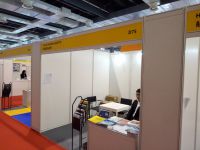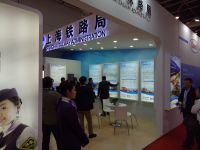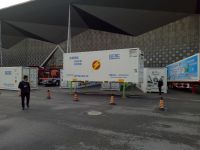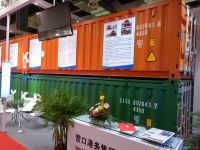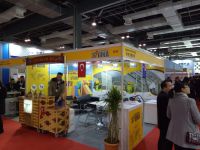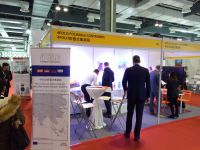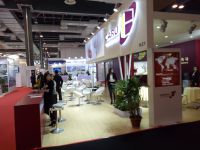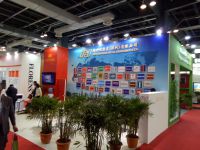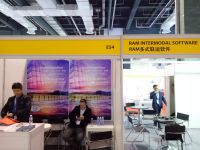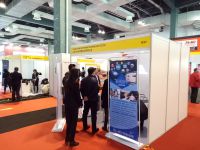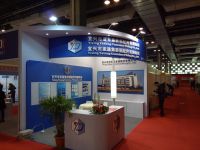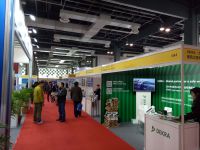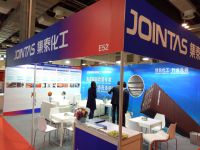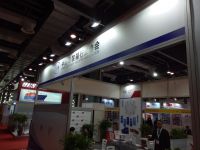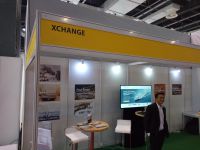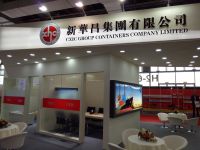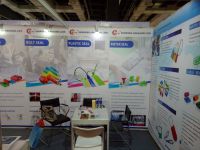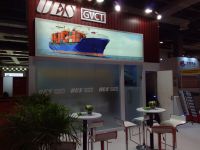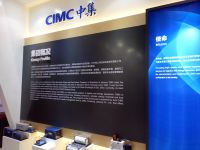On March 21 I visited the Intermodal Asia 2017 exhibition and conference in Shanghai, China. Intermodal logistics is about transporting goods by using multiple different means of transportation. A typical scenario can be to transport products from a factory to a train station with a truck, then with a train to a port, then via ship to a destination port, then via train to the destination city, and from there via truck to the customer. The center of this conference therefore are logistics, containers and products surrounding them, and how to transport them via trains and ships. There were many exhibiting companies, presenting products such as different container types, anti-corrosive colors, container locks, container spare parts, sharing and leasing services for containers, management software, wood, rubber, and metal products used in the context of transportation, classification and quality control for containers and their production, as well as intermodal logistics services, and transportation-centered newspapers and journals. In the innovation and technology theaters, speakers presented the newest trends and technological advances of the fields. I found this conference very inspiring, as I could learn a lot of new aspects of the intermodal logistics industry and have a few interesting discussions.
One important topic for logistics is clearly the Belt and Road Initiative [一带一路], which will establish several railways and sea-ways in order to achieve a better logistic connectivity of China and Europe through several Asian countries. However, I am personally most interested in how IT can support logistics and how far such support is adopted and utilized by the major players. Several of the speakers and also some of the services offered by exhibitors confirm that there is a very strong trend towards digitalization of logistics. Containers here are the central asset. The management of containers is supported by internal and global data bases, for instance. More and more precise information is collected. Of course, the more information exist, the more we can do with it, including automated planning, data mining, and big data analytics. It is pointed out that big players such as Amazon and UPS already use computational intelligence technologies to optimize their logistics and that such companies aim to reduce costs of every possible aspect of logistics – even in cases where the savings are relatively small, because every penny counts.
As a researcher in optimization and operations research, this was particularly interesting for me, as I can confirm that optimization can truly increase the efficiency and reduce the cost of logistics quite a lot. We have contributed significantly to logistics planning problems over the years, including, for instance to real-world scenarios like in the in.west project, involving different vehicles, trains, time windows, different capacity limits, etc. in the domain of swap-body based transportation in nation-scale by a commercial logistics company. We also conduct state-of-the-art research on theoretical problems such as the Traveling Salesman Problem.
-
Thomas Weise, Alexander Podlich, Kai Reinhard, Christian Gorldt, and Kurt Geihs. Evolutionary Freight Transportation Planning. In Applications of Evolutionary Computing – Proceedings of EvoWorkshops 2009: EvoCOMNET, EvoENVIRONMENT, EvoFIN, EvoGAMES, EvoHOT, EvoIASP, EvoINTERACTION, EvoMUSART, EvoNUM, EvoSTOC, EvoTRANSLOG (EvoWorkshops'09), volume 5484/2009 of Lecture Notes in Computer Science (LNCS), pages 768-777, Tübingen, Germany, April 15–17, 2009. ISBN: 978-3-642-01128-3, Berlin, Germany: Springer-Verlag GmbH.
doi:10.1007/978-3-642-01129-0_87 / pdf / slides - Thomas Weise, Raymond Chiong, Ke Tang, Jörg Lässig, Shigeyoshi Tsutsui, Wenxiang Chen, Zbigniew Michalewicz, and Xin Yao. Benchmarking Optimization Algorithms: An Open Source Framework for the Traveling Salesman Problem. IEEE Computational Intelligence Magazine (CIM), 9(3):40-52, August 2014.
doi:10.1109/MCI.2014.2326101 / pdf
Anyway, digitization was one of the topics of the conference, although I perceived it not as the central point yet. Clearly, the really big global companies are the first to invest money to explore such opportunities. Nevertheless, the trend is there and an increased use of management databases, software, and Internet connectivity will automatically decrease the hurdle to apply more advanced computational and business intelligence. No company can ignore the potential savings of resources in the long run.
One situation where this already takes place is container backhaul: A container is an expensive and important asset. If we need to transport a certain product from a source to a destination, we want to get the container back afterwards. However, our company may have nothing to transport back, so that the container backhaul is an empty transport. Services try to tackle this issue by matching customers seeking containers for transporting something from A to B and those who have empty containers they need to transport from B to A. They make use of the fact that most of the empty container backhauls result from transportation imbalances inside a company, while the imbalances are much smaller from a global perspective. I think a company would probably not naturally provide its containers to others, but the advantage of the resulting savings are attractive, so they will do it.
Anyway, this conference was a really nice event. It showed that the field of intermodal logistics is very diverse with many different players and services. It is much more than just getting a container from A to B. I hope that I can attend this conference again next year.



